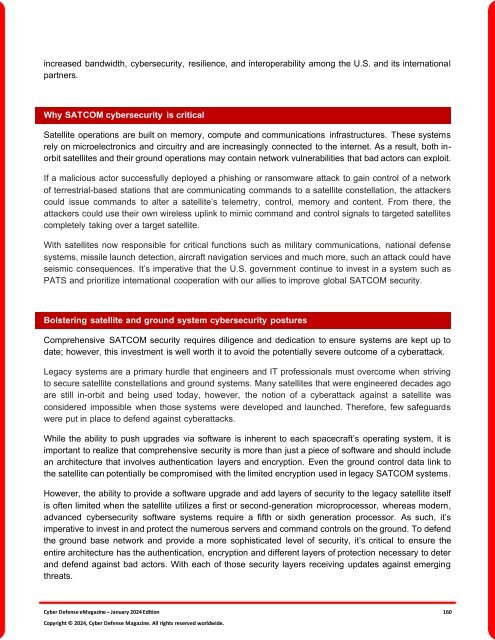The Cyber Defense eMagazine January Edition for 2024
Cyber Defense eMagazine January Edition for 2024 #CDM #CYBERDEFENSEMAG @CyberDefenseMag by @Miliefsky a world-renowned cyber security expert and the Publisher of Cyber Defense Magazine as part of the Cyber Defense Media Group as well as Yan Ross, Editor-in-Chief and many more writers, partners and supporters who make this an awesome publication! 201 page January Edition fully packed with some of our best content. Thank you all and to our readers! OSINT ROCKS! #CDM #CDMG #OSINT #CYBERSECURITY #INFOSEC #BEST #PRACTICES #TIPS #TECHNIQUES
Cyber Defense eMagazine January Edition for 2024 #CDM #CYBERDEFENSEMAG @CyberDefenseMag by @Miliefsky a world-renowned cyber security expert and the Publisher of Cyber Defense Magazine as part of the Cyber Defense Media Group as well as Yan Ross, Editor-in-Chief and many more writers, partners and supporters who make this an awesome publication! 201 page January Edition fully packed with some of our best content. Thank you all and to our readers! OSINT ROCKS! #CDM #CDMG #OSINT #CYBERSECURITY #INFOSEC #BEST #PRACTICES #TIPS #TECHNIQUES
You also want an ePaper? Increase the reach of your titles
YUMPU automatically turns print PDFs into web optimized ePapers that Google loves.
increased bandwidth, cybersecurity, resilience, and interoperability among the U.S. and its international<br />
partners.<br />
Why SATCOM cybersecurity is critical<br />
Satellite operations are built on memory, compute and communications infrastructures. <strong>The</strong>se systems<br />
rely on microelectronics and circuitry and are increasingly connected to the internet. As a result, both inorbit<br />
satellites and their ground operations may contain network vulnerabilities that bad actors can exploit.<br />
If a malicious actor successfully deployed a phishing or ransomware attack to gain control of a network<br />
of terrestrial-based stations that are communicating commands to a satellite constellation, the attackers<br />
could issue commands to alter a satellite’s telemetry, control, memory and content. From there, the<br />
attackers could use their own wireless uplink to mimic command and control signals to targeted satellites<br />
completely taking over a target satellite.<br />
With satellites now responsible <strong>for</strong> critical functions such as military communications, national defense<br />
systems, missile launch detection, aircraft navigation services and much more, such an attack could have<br />
seismic consequences. It’s imperative that the U.S. government continue to invest in a system such as<br />
PATS and prioritize international cooperation with our allies to improve global SATCOM security.<br />
Bolstering satellite and ground system cybersecurity postures<br />
Comprehensive SATCOM security requires diligence and dedication to ensure systems are kept up to<br />
date; however, this investment is well worth it to avoid the potentially severe outcome of a cyberattack.<br />
Legacy systems are a primary hurdle that engineers and IT professionals must overcome when striving<br />
to secure satellite constellations and ground systems. Many satellites that were engineered decades ago<br />
are still in-orbit and being used today, however, the notion of a cyberattack against a satellite was<br />
considered impossible when those systems were developed and launched. <strong>The</strong>re<strong>for</strong>e, few safeguards<br />
were put in place to defend against cyberattacks.<br />
While the ability to push upgrades via software is inherent to each spacecraft’s operating system, it is<br />
important to realize that comprehensive security is more than just a piece of software and should include<br />
an architecture that involves authentication layers and encryption. Even the ground control data link to<br />
the satellite can potentially be compromised with the limited encryption used in legacy SATCOM systems.<br />
However, the ability to provide a software upgrade and add layers of security to the legacy satellite itself<br />
is often limited when the satellite utilizes a first or second-generation microprocessor, whereas modern,<br />
advanced cybersecurity software systems require a fifth or sixth generation processor. As such, it’s<br />
imperative to invest in and protect the numerous servers and command controls on the ground. To defend<br />
the ground base network and provide a more sophisticated level of security, it’s critical to ensure the<br />
entire architecture has the authentication, encryption and different layers of protection necessary to deter<br />
and defend against bad actors. With each of those security layers receiving updates against emerging<br />
threats.<br />
<strong>Cyber</strong> <strong>Defense</strong> <strong>eMagazine</strong> – <strong>January</strong> <strong>2024</strong> <strong>Edition</strong> 160<br />
Copyright © <strong>2024</strong>, <strong>Cyber</strong> <strong>Defense</strong> Magazine. All rights reserved worldwide.

















